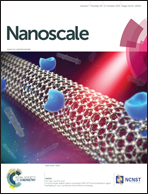High-quality elliptical iron glycolate nanosheets: selective synthesis and chemical conversion into FexOy nanorings, porous nanosheets, and nanochains with enhanced visible-light photocatalytic activity†
Abstract
This paper describes an original and facile polyol-mediated solvothermal synthesis of elliptical iron glycolate nanosheets (IGNSs) combined with precursor thermal conversion into γ-Fe2O3 and α-Fe2O3/γ-Fe2O3 porous nanosheets (PNSs), α-Fe2O3 nanochains (NCs), and elliptical Fe3O4 nanorings (NRs). The IGNSs were produced via the oxidation–reduction and co-precipitation reactions in the presence of iron(III) salts, ethylene glycol, polyethylene glycol, and ethylenediamine. Control over Fe3+ concentration, temperature, and time can considerably modulate the size and phase of the products. The IGNSs can be transformed to γ-Fe2O3 and α-Fe2O3/γ-Fe2O3 PNSs, α-Fe2O3 NCs, and elliptical Fe3O4 NRs by heat treatment under various annealing temperatures and ambiences. The PNSs and NCs exhibited high soft magnetic properties and coercivity, respectively. Visible-light photocatalytic activity toward RhB in the presence of H2O2 by PNSs and NCs was phase-, SBET, size-, porosity-, and local structure-dependent, following the order: α-Fe2O3 NCs > α-Fe2O3/γ-Fe2O3 PNSs > γ-Fe2O3 PNSs > IGNSs. In particular, α-Fe2O3/γ-Fe2O3 PNSs possessed significantly enhanced photocatalytic activity with good recyclability and could be conveniently separated by an applied magnetic field because of high magnetization. We believe that the as-prepared α-Fe2O3/γ-Fe2O3 PNSs have potential practical use in waste water treatment and microwave absorption.


 Please wait while we load your content...
Please wait while we load your content...